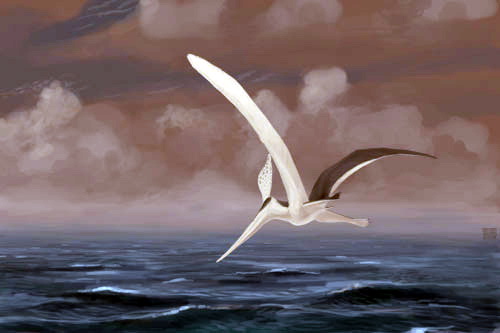Pteranodon - Wiki Pteranodon
From Wikipedia, the free encyclopedia
[Photo] The pterodactyloid pterosaur Pteranodon sternbergi by John Conway http://palaeo.jconway.co.uk/
Fossil range: Mid-Late Cretaceous
Species
Pteranodon longiceps (type)
Pteranodon sternbergi
Pteranodon (from Greek πτερ- "wing" and αν-οδων "toothless"), from the Late Cretaceous (Coniacian-Campanian, 89.3-70.6 million years ago) of North America (Kansas, Alabama, Nebraska, Wyoming, and South Dakota) was one of the largest pterosaur genera, with a wingspan of up to 9 m (30 feet).
Unlike earlier pterosaurs such as Rhamphorhynchus and Pterodactylus, Pteranodon had toothless beaks, like modern birds.
Pteranodon fossils have been generally found in the Cretaceous chalk beds of Kansas. These chalk beds were deposited at the bottom of what was once an epicontinental seaway on what is now the North American continent. The first Pteranodon skull was found on May 2, 1876, in the Smoky Hill River in Wallace County, Kansas, USA, by S. W. Williston, a fossil collector working for Othniel Marsh. The Niobrara Formation is possibly the most famous unit here, and other fossils found in this formation include those of sea turtles, mosasaurs, and early birds.
Pteranodon were reptiles, but not dinosaurs. By definition, all dinosaurs were diapsid reptiles with an upright stance, and consist of the group containing saurischians and ornithischians. While the advanced pterodactyloid pterosaurs (like Pteranodon) had a semi-upright stance, it evolved independently of the upright stance in dinosaurs, and pterosaurs lacked the distinctive adaptations in the hip associated with the dinosaurian posture. However, dinosaurs and pterosaurs may have been closely related, and most paleontologists place them together in the group Ornithodira, or "bird necks".
Discovery and species
A number of species of Pteranodon have been named, the most well-supported being the type species, P. longiceps. This was discovered by Othniel Charles Marsh in 1876. This had a wingspan of 9 m (30 ft). Other species include the slightly smaller P. sternbergi, with a wingspan of 6 m (20 ft), P. occidentalis, P. velox, P. umbrosus, P. harpyia, and P. comptus. Many are dubious and may be synonymous with the more well-known species. Marsh identified Pteranodon as "distinguished from all previously known genera of the order {pterosauria} by the entire absence of teeth." This meant that any toothless pterosaur jaw fragment, wherever it was found in the world, tended to be attributed to Pteranodon. Hence there came to be a plethora of species and a great deal of confusion. The name became a wastebasket taxon, rather like the dinosaur Megalosaurus, to label any pterosaur remains that could not be distinguished other than by the absence of teeth. Notable authors who have discussed the various aspects of Pteranodon include Bennett, Padian, Unwin, Kellner, and Wellnhofer. One species, P. orogensis is not actually a pteranodontid and has been renamed Bennettazhia oregonensis. Likewise, P. orientalis has been renamed Bogolubovia orientale (Nessov & Yarkov, 1989) and transferred to the Azhdarchidae.
Paleobiology
The diet of Pteranodon is known to have included fish; fossilized fish bones have been found in the stomach of one Pteranodon, and a fossilized fish bolus has been found between the rami of another Pteranodon. Pteranodon's wing shape suggests that it would have flown rather like a modern-day albatross, soaring by navigating through thermals. This is a suggestion based on the fact that the Pteranodon had a high aspect ratio (wingspan to chord length) similar to that of the albatross ??? 9:1 for Pteranodon, compared to 8:1 for an albatross. However, other scientists have suggested that Pteranodon could flap their wings and fly with power. They flew long distances using large, light-weight wings.
Pteranodon was notable for its skull crest. These may have been used as mating displays, or it might have acted as a rudder, or perhaps both. It has been suggested that males of the species bore larger crests, but with fossil animals it is often difficult to tell whether differences in crest shape reflect different sexes or different species.
Consensus regarding the terrestrial locomotion of Pteranodon (whether it was bipedal or quadrupedal) has historically been the subject of debate. Today, most pterosaur researchers agree that pterosaurs were quadrupedal, thanks largely to the discovery of several pterosaur trackways. The possibility of swimming has been discussed briefly in two papers (Bennett 2001 and Bramwell & Whitfield), and is currently being studied in detail at Michigan State University through the use of quantitative morphometrics and an extant phylogenetic bracket (a morphologically comparative technique invented by Larry Witmer).
In popular culture
In colloquial language, Pteranodon is often erroneously called the "pterodactyl." However, "pterodactyl" is not actually the name of a specific species; rather, it is a term for all short-tailed pterosaurs (the suborder Pterodactyloidea), which includes Pteranodon, Pterodactylus, and Quetzalcoatlus. This misuse is most likely due to Pteranodon's high profile in popular culture as the quintessential pterodactyloid.
Pteranodon was seen briefly at the end of the 1997 film The Lost World: Jurassic Park, and also appeared in its sequel, Jurassic Park III. The depiction in Jurassic Park III featured many inaccuracies, including toothed jaws, exaggerated strength and, presumably, aggression. (Pteranodon is thought to have eaten fish, and was incapable of grasping with its feet). More scientifically accurate Pteranodon appeared in the television programs Chased by Dinosaurs and Sea Monsters.
http://en.wikipedia.org/wiki/Pteranodon
| The text in this page is based on the copyrighted Wikipedia article shown in above URL. It is used under the GNU Free Documentation License. You may redistribute it, verbatim or modified, providing that you comply with the terms of the GFDL. |
